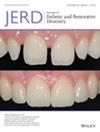The Effect of Plaque Detectors on the Color Stability of Two Types of Restorative Materials
Abstract
Objective
To investigate the color stability of a one-shade resin-based composite material (RC) and a glass-ionomer cement (GIC) after staining with plaque detectors (PDs) with different formulations and delivery forms.
Materials and Methods
Rectangular-shaped specimens (7 × 3 × 2 mm) were produced with RC (Venus Diamond One, Kulzer) and GIC (Fujy IX GP, GC) (n = 30). Further, the following PDs were used on the specimens: (1) tablets (T; Plaq-Search, TePe); (2) mouthwash (M; Plaque Agent, Miradent); and (3) light-curing liquid (L; Plaque test, Ivoclar). The PDs were removed with dedicated toothbrushes (T1) and the specimens were repolished (T2). The protocol was repeated after 1 week of storage in artificial saliva (staining—T3 and repolishing—T4). Color measurement were performed at baseline (T0) and all testing times (T1—T4) using a recently introduced digital colorimeter (SmartColor, Smart Vision). Color changes (ΔE ab) compared to T0 were automatically recorded by the digital instrument. The data were statistically analyzed (p < 0.05).
Results
The type of PD, the polishing procedure and their interactions influenced the color stability of both restorative materials (p < 0.05). Particularly, after the second PDs application, M and L produced the highest color changes (p < 0.05), with GIC showing higher color variability than RC. Although repolishing reduced the color changes of RC (p < 0.05), it could not reestablish the initial color of GIC, irrespective of the PD used (p < 0.05). Except for RC associated with T, all materials exhibited discoloration above the clinical perceptibility (1.77) and acceptability (2.66) thresholds.
Conclusions
The influence of PDs on the color stability of RC and GIC was material-dependent. GIC showed higher color instability than RC. Repolishing could not reestablish the original color of GIC and only attenuated the color changes of the one-shade RC. The newly introduced digital colorimeter was an important tool to standardize and simplify color measurement evaluations.
Clinical Significance
PDs can pose a potential risk to the color stability of restorative materials. Dental practitioners should be careful when recommending the frequency of at-home application of PDs, taking into consideration the material properties and the position of the restorations of each patient.

 求助内容:
求助内容: 应助结果提醒方式:
应助结果提醒方式:


